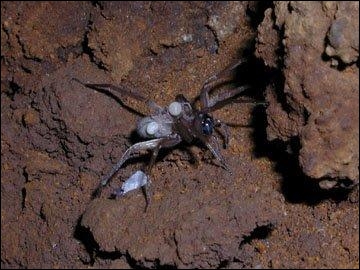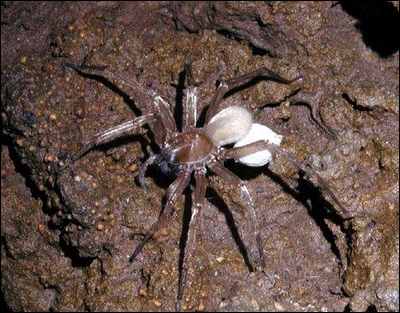| "This unique eyeless wolf spider is the most remarkable cave species in
Hawaii," said Dr. Frank Howarth, an entomologist from Bishop Museum
considered by many to be the leading expert on the Kauai cave wolf spider.
"Besides being perfectly adapted to life in the dark lava tubes of Kauai,
like their big-eyed surface relatives, cave wolf spiders share a special
adaptation" their spiderlings have a row of comb-like teeth on their claws
that perfectly match the spaces on the multi-branched hairs found on the
mother's back. This match allows the spiderlings' to hold on for safe
transport and protection by the mother."
In late November 2005, U.S. Fish and Wildlife Service biologist Gordon
Smith and University of Hawaii graduate student Wendy McDowell -
accompanied by representatives from the private lands that harbor this rare
spider - conducted cave surveys of the spider's habitat. The team observed
two hatched and two unhatched (still in the egg case) spiderlings.
Biologists point out that there may have been more spiderlings present in
areas inaccessible to the team. The Service has been conducting regular
cave surveys of the spider and another endangered species, the Kauai cave
amphipod, for the past 10 years.
|
| The biologists survey all accessible spider habitats, identify immature and
adult spiders, note the quality and condition of the habitat and determine
the sex of the adults. Since 1996, biologists have occasionally seen
spiders with egg cases but they had never seen spiderlings until that
fateful day in November. |
 |
|
Dr. Howarth and McDowell suggest that this very special sighting may be
attributed to several factors such as regular surveys for the past 10
years, an increase in the number of Kauai cave amphipods - believed to be a
primary food source for the spiders, improved surface habitat providing
more food for the amphipods, or just seasonal variability. The Service
hopes that McDowell's research will provide a better understanding of the
spider's life history and its habitat needs.
Little is known about this rare spider, first discovered in 1971, which is
found only in the lava tubes and cave-bearing rock in Kauai's Koloa Basin.
The species has been documented in five different caves within the basin,
but has only been observed regularly in one of these caves.
"The Service has worked closely with the private landowners whose property
harbors spider habitat," said Lorena Wada, fish and wildlife biologist with
the U.S. Fish and Wildlife Service's Pacific Islands Fish and Wildlife
Office. "These private landowners have been instrumental in protecting
critical habitat, permitting scientific researchers' access to these highly
sensitive habitats, and enhancing public knowledge of and support for
protecting these species."
The primary threat to the Kauai cave wolf spider is human-caused
destruction or degradation to their highly sensitive cave habitat. To
protect the cave systems, the Service is working with private landowners to
control human entry, prevent the destruction of native plant communities
above the cave systems, prevent the introduction of nonnative predators and
competitors and control those already present.
 Protecting the cave itself is important, but proper management of the
habitat above the caves is essential to encourage the growth of appropriate
plants whose roots provide food and debris for the cave amphipod and to
increase the relative humidity in caves. Both these cave-dwelling species
appear to require high humidity, perhaps as much as 100 percent. Protecting the cave itself is important, but proper management of the
habitat above the caves is essential to encourage the growth of appropriate
plants whose roots provide food and debris for the cave amphipod and to
increase the relative humidity in caves. Both these cave-dwelling species
appear to require high humidity, perhaps as much as 100 percent.
The Kauai cave wolf spider is a mid-size (0.50 to 0.75-inch) hunting spider
that has completely lost its eyes as part of its adaptation to life in lava
tubes. Instead of building webs, it chases and grabs its prey or may
utilize sit-and-wait ambush tactics. Unlike most wolf spiders that produce
100 to 300 spiderlings per clutch, the Kauai cave wolf spider is believed
to produce fewer than 30 spiderlings per clutch. Newly hatched spiderlings
are unusually large and are carried on the back of the female for only a
few days.
For more information about Hawaii's endangered and threatened species,
visit the Service's website at
http://www.fws.gov/pacificislands/ .
|